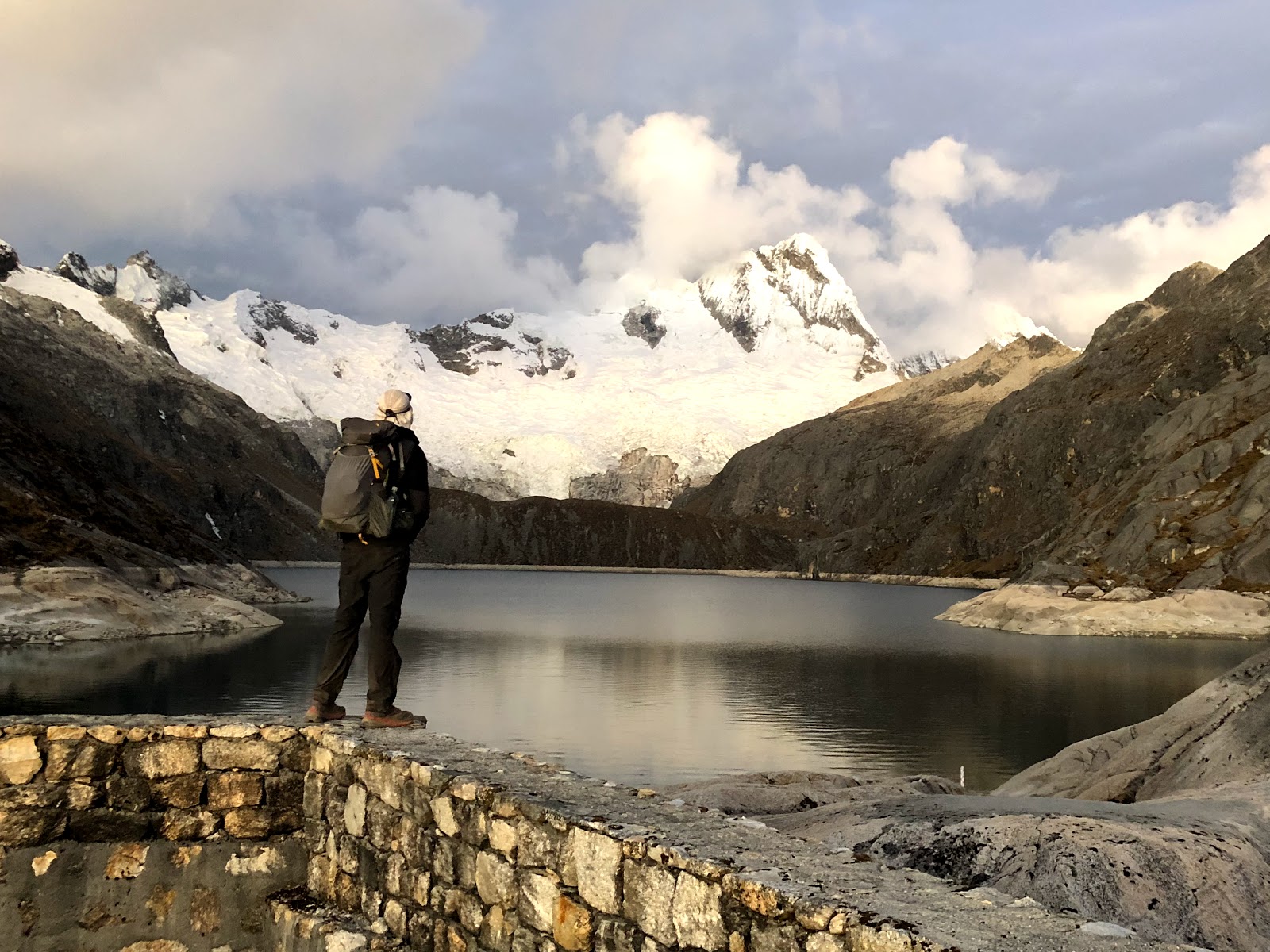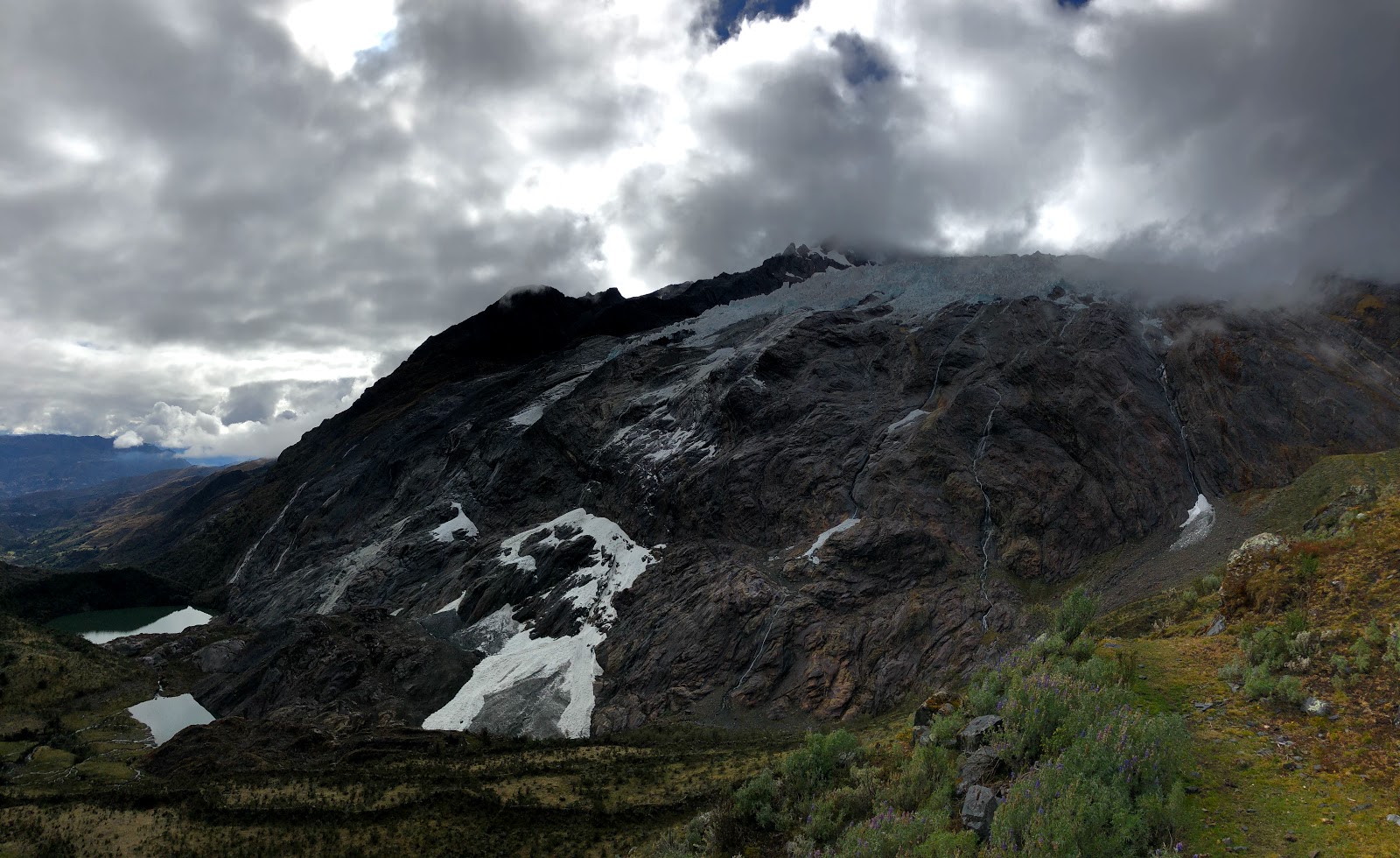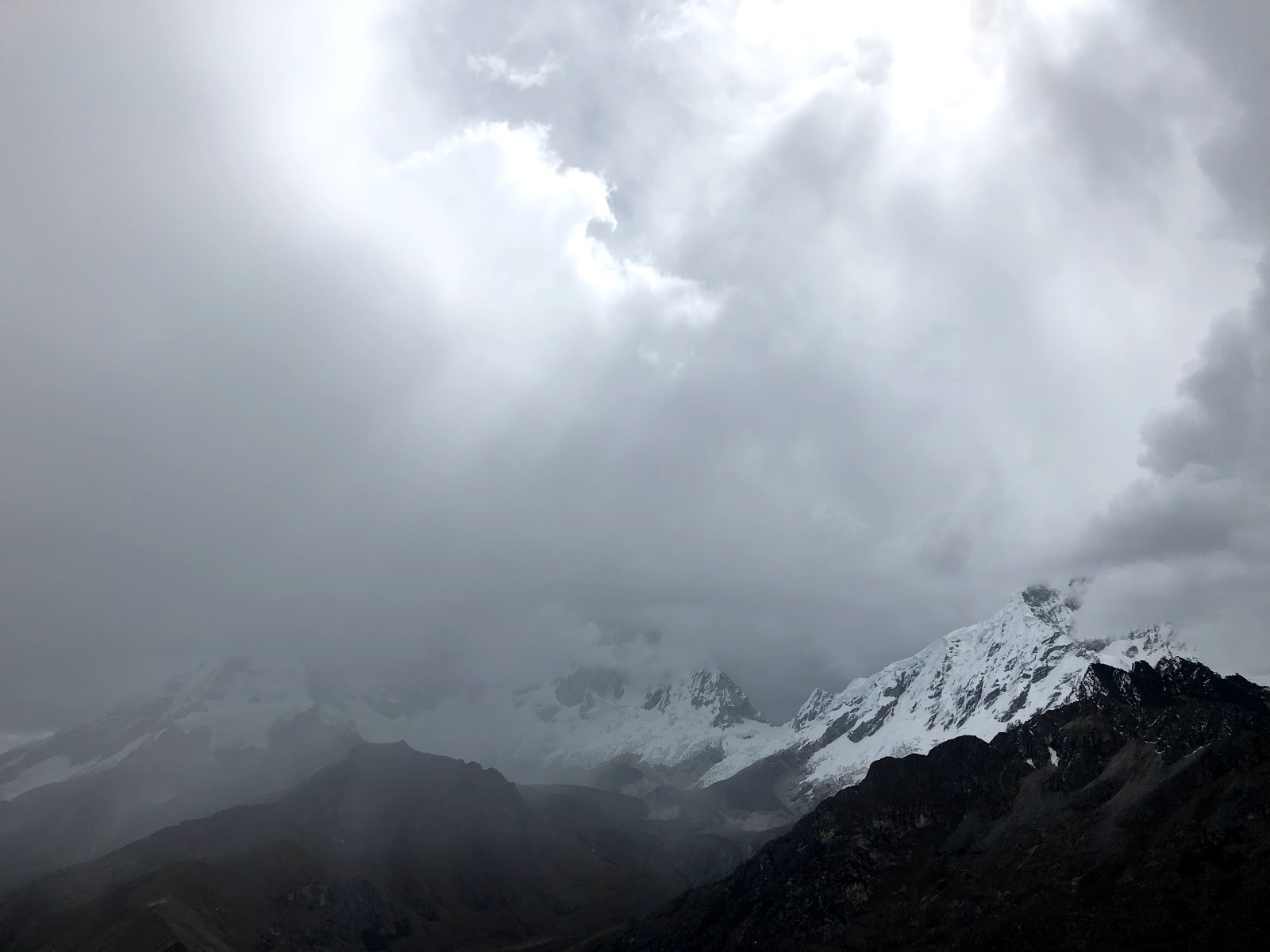Stage 1, (94-100m)
Day 1:
5000ft climb through chaparral type vegetation to plump tufts of grassy expanses to sheer trail cut in the rock. The aqueduct flowed with theme park type water raging through a chute just dying to be rode in a log tram, the actual trail beautifully constructed with tedious care to pick apart the best way through. At one point, we noticed we were walking above a condor cruising the thermals a thousand or so feet below us in a dizzying chasm. An enormous waterfall cascaded down black cliffs, the spindrift from the fall dissipating into a deep hanging valley filled with a startling deep blue lake. To our delight and sheer glee we found a shelter at 15000ft at the foot of a durably constructed dam that held water wedged between a stalwart cliff and a massive moraine containing another lake behind it backdropped by sheer faces of glacier clad peaks towering over everything, the biggest glacier folded and crammed into a high pocket like sheets folded and pleated over and over again until a tight formation is displayed for an inspecting officer.
Day 2:
4 passes, including Osuriri and Gara Gara pushing near 16000 feet. The pyramidal block of Alpamayo briefly appeared further down valley than we hoped for. Nevertheless we were happy to see the sight. Clouds moved in and smothered most of the peaks, which then highlighted the cleaved and jumbled glaciers tucked under the peaks. The 3 pronged Santa Cruz Peaks piqued a skyline downright menacing as we climbed towards Gara Gara. Above the tough bunch grass the world turned to rock, the ground saturated from a previous day’s rain and melted snow. After the high pass we ambled down a high grassy valley along perfect trail, although some parts littered with loose and bumbling rock. We camped in a large valley at a very soothing low elevation of 13000ft, while aware of the notion the 3 6000m peaks of the Pucajirca massif towering above us. Exhausted we laid in our tarps on a bench above the river. Wooly horses fed on the tough pampa grasses on the other side of the river.
Push, sometimes, well, most of the time, all I know is to push. I push boundaries, pushing limits probably the most; tempers, personalities, feelings, hell I can be a bugger of an asshole. I know it’s my drive, like I exert will power in everything. The strange fact is because I’ve got a big heart I feel guilty if I exert too much push on others. Because I see the strain or the unnerving or the lack of interest or the distemper or the detachment or anger. Sometimes I’m too results oriented that constructs my madness to push. I’m all in all the time. And while I feel I’ve adapted to others’ feelings and wants over the years, sometimes I’m just too corkscrewed driven and mad to see what’s in front of me, the bull going straight through. All I want to do is play, really hard, in these high Andean mountains. Really, truly I do. Let the range dictate the day. Because I’ll listen. I really will.
Day 3:
Paso Yanacon, quick and steep up a groovy green ramp. At the top, a wall built of large scree rock spanned between a large and pointy outcrop and a craggy ridge that we used to keep warm from the chilly wind. Glaciers above us hung over colorful rainbow striations strung against sheer rock faces, like an eroded and torn birthday stringer.
Probably the largest glacier we’ve seen yet under Nevados Pucajirca in the Quebrado Jancapampa drainage loomed over us. Our eyes bugged out of our head, the mountains showing the modesty of a floozy. A giant ‘V’ with ribbons of water plummeting thousands of feet to a moraine while polishing the fierce head wall stained red and dirty from glacial ice. We ate lunch at a piled sod bridge lined with quenhua poles. Hundreds of grazing animals lolled about the pampa gnawing and nibbling on grass and roots. Pigs, burros, hundreds of sheep, horses and cows—-the whole agricultural lot, all woolier than our American counterparts.
At Paso Tupatupa, expansive views strung out to the southern reaches of the Cordillera Blanca, while the famous peak of Alpamayo revealed the beautiful triangular pinnacle along a voracious skyline resembling hungry jaws of some cold predator harkening doom from the sky. Everything here can be hidden only showing a tantalizing glimpse of the harsh beauty the mountains reveal. The range circulates and develops its own weather—- swirling clouds, thick yet wispy, rove through ridge lines, banks of fog, icy and incandescent, plunge into serrated and pointy peaks and turrets and pinnacles; the sun when out scorches the exposed skin yet makes the heavens dreamy and sublime, the refulgence of the temples of rock enlightened by the ethereal rays of the blazing orb; you take what you get out here, every second an opportunity of wonder, every second a speck of change that drastically shapes growth and inspires a simplicity of awe.
That night we camped on the porch of a fisherman’s refugio overlooking Lago Wicrococha. At the boat dock, two half submerged wooden dinghies colored delightfully hung sullen under the light, the trout of the lake just as delightfully sullen from something unused yet unplayed with. To not play with a toy is a slow death, even though death is toying with us. The clouds over the high peaks turned peach until darkness reigned and we marveled at the stars and the planets of the Southern Hemisphere.
Day 4:
A tale of two days. The animals seemed a bit surly because of the rain and drizzle—-horses bucking, cows charging, pigs grunting and their hair standing in razorback fashion. The trail weaved in a manner of ease despite the elevation. At the pass freezing snowflakes, crystallized vapor from the clouds we were amidst, fell on our shoulders and pelted our beards. Down a spiraling rocky trail the valley opened up down below us. We spotted llamas finally as I said surprised, ‘That’s a long neck for a cow.’
Then, we had a pleasant walk through villages with tall eucalyptus shimmering in the light breeze, small hand started fires made the air pungent of oils mixed with dried and dead grass, and guided trekkers went the opposite direction having just started their trek, the strain of work on their face. We had a long break in the village of Colcabamba in the shade of perpetual construction lazing away the day in a lazy fashion. I’m nicer here. Maybe it’s the thoughtful and heartfelt Bobby and Steph. And I joke in insecurity in being too nice: ‘I’m down for swapping spit but hell if I’m for swapping snot.’ Like I’ll always be on guard. However, I am aware of an unwanted prejudice, towards the cows and people of the US and not the cows and people of Peru. I am truly nicer here than stateside. Can prejudice be from your environment? Or am I just tired of the whining and complaining of the States? The greed, the gluttony, the ease of life and the taking for granted of so many things, the uber political sides? I don’t know how to explain it. My feeble attempt: when I look at cows here I see beauty, color, hard work, toughness, niceness, adapting to conditions and the environment, working together, playfulness, and the opposite of a disassociation with the cows and an owner who I dislike. Maybe it’s the having nothing much in common but the land. Up there, in the States, we abide by the commonalities of things. Maybe I’m prejudice against things that dilute or blind a nation, a race of things. I digress, but I’m for the land, and the people of the land. Or maybe I’ve not been here long enough. I’m sure my niceness comes in waves, mainly in newness, or change of scenery.
Day 5:
Remnants of an an Incan trail/road led us up a steep and narrow valley. Throughout the night I thought I heard ice or rock fall but I had not been sure exactly what I had been hearing. At a stone corral, with wooly, colorful and curious cows, the answer came from above. The tempestuous glacier of Nevado Contrahierbas roared to life as an oozing mass of enormous ice chunks and compacted snow, a river of ice, cerulean blue and fantastically white, went cascading and tumbling over the polished and varnished edge of steel gray and black cliffs through worn chutes and rounded edges. What started as a white tongue turned into a glacial tsunami, the noise deafening and bouncing off of the surrounding walls all the while the cows hardly flinched and kept their stare straight at us. The aftermath of glittering water gleaming in the sun’s reflection streamed down the chutes while towards the bottom the ice detritus flowed in gullies like pure water appearing soft as wet sand. Aftershocks upon aftershocks, roar upon roar, the sound of airplanes above us, the torn and cleaved scarring from main body, an unbirth of a breaking synergy of something powerful turned to bits, a death of sorts, a melting of the madness of reality of another world, as we twisted up myriad of curly cue switchbacks along the ancient path of the ancient people—- the glacier is alive, always has been. Here it is in front of us: a life of constant change, harsh yet tender, cleaning and dividing yet full of new creation.
After the excitement, we kept excited at a narrow cliff ban that held a sliver of undulating trail clinging to the walls until we attained a notch. To the west, Nevado Huascaran, the highest peak of Peru, stood smothered in roving clouds. Adrenaline flowed from the morning and we zipped down the switchbacks, even crossing iron stained water and rock making a palette of color of the very high alpine area.
Punta Olimpica and the world’s highest vehicular tunnel provided the thoroughfare back to the eastern side of the Peruvian Andes. Huge 6000m peaks highlighted the skies through thick clouds, the peaks even packed with precariously hanging glaciers that resembled the droopy underparts of the stormy clouds. These dreamy and dark cells floated down pellets of ice and snow, a flurry of graupel that pecked at our outer shells. In the tunnel we acted like kids all over again until a trudge became a trudge and the cold sank in. The roof of the tunnel leaked and rained down on us, our headlamps creating spooky and looming shadows down the corridor. We still laughed and whistled most of the way while watching for headlamps or listening for the groan of a vehicle coming from behind us. Out the other end the snow came down harder. So, we scurried down the paved switchbacks on meager trail although steep and muddy. On and on and on we went down the valley determined to get to Pompey to scrounge up a hitch to Chacas. Our long and eventful day succumbed to dark, however, our luck continued as an Italian parishioner, now a Peruvian, gave us a lift to Chacas under dim streetlights just as our prospects of camp and/or sleep and/or food and/or a place to stay were running out of hope. We sat down to two pizzas apiece and reflected with laughter and awe at the day we had shared and experienced.




















































Hi, your pictures are amazing! I will be in Peru hiking this year, could you please share tour tracklog? Thanks!
ReplyDelete